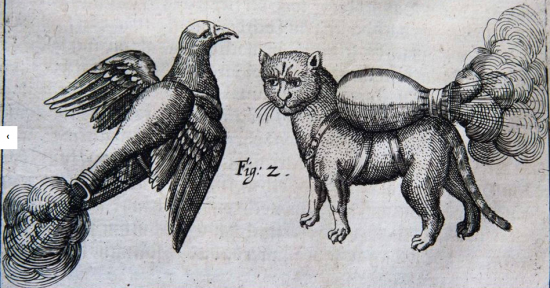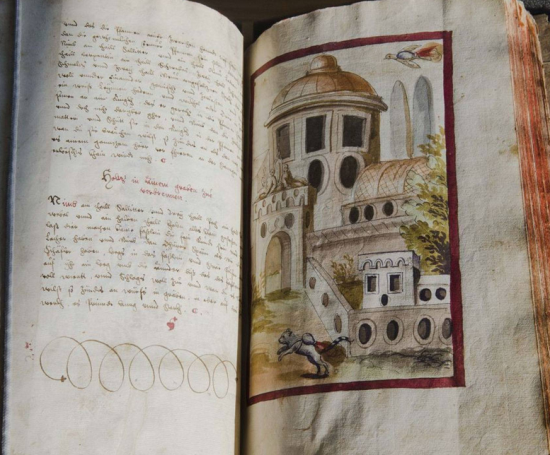Animals strapped with explosives were used as weapons according to a 16th century illustrated German manuscript
Rob Williams
Source - http://www.independent.co.uk/news/world/europe/i-can-haz-rocket-16thcentury-warfare-manual-showing-rocket-cats-weaponry-puzzles-experts-9173808.html

A bird and a cat strapped with explosives fly towards a castle. Illustration from an artillery manual by Franz Helm, c. 1530. Digitized by the University of Pennsylvania. Image: The Independent.
From Nyan cat to leaping feline fails the airborne moggie is quite rightly a harmless obsession for those who create internet memes.
Experts studying fanciful illustrations from a circa-1530 manual on artillery and siege warfare, however, appear to have uncovered a less innocent use for cats in flight.
Images from the manual, which was digitised by the University of Pennsylvania, appear to show jet packs strapped to the backs of cats and doves.
The German text accompanying the pictures helpfully advises military commanders to use them to "set fire to a castle or city which you can't get at otherwise."
The pictures showing cats and doves being propelled towards a castle by what appear to be jet-packs appear in a“Feuer Buech” manuscript that has now got experts puzzled.
The treatise in question was written by artillery master Franz Helm of Cologne, who was believed to have fought in several skirmishes against the Turks in south-central Europe at a time when gunpowder was changing warfare.

Circulated widely and illustrated by multiple artists, Helm's manual is filled with all sorts of strange and terrible imagery, from bombs packed with shrapnel to missile-like explosive devices studded with spikes — and those weaponised cats and birds.
The unusual, full-colour illustrations of incendiary-bearing cats and birds recently caught the attention of an Australian book blog and then found their way to Penn researcher Mitch Fraas, who set out to unravel the mystery.
"I really didn't know what to make of it," said Fraas, a historian and digital humanities expert at the Penn library. "It clearly looks like there's some sort of jet of fire coming out of a device strapped to these animals."
According to Fraas' translation, Helm explained how animals could be used to deliver incendiary devices: "Create a small sack like a fire-arrow . If you would like to get at a town or castle, seek to obtain a cat from that place.
"And bind the sack to the back of the cat, ignite it, let it glow well and thereafter let the cat go, so it runs to the nearest castle or town, and out of fear it thinks to hide itself where it ends up in barn hay or straw it will be ignited."

In other words, capture a cat from enemy territory, attach a bomb to its back, light the fuse and then hope it runs back home and starts a raging fire.
Fraas said he could find no evidence that cats and birds were used in early modern warfare in the way prescribed by Helm.
"It's sort of a harebrained scheme," Fraas said. "It seems like a really terrible idea, and very unlikely the animals would run back to where they came from. More likely they'd set your own camp on fire."
Additional reporting by Associated Press.